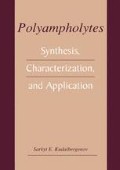Abstract
The development of polymeric catalysts, which act likes enzymes is of great interest.1–6 Synthetic polyampholytes due to high content of functional groups and rich conformational liability are best candidate to design active and selective catalysts.7 Electrostatic interactions, hydrogen and coordination bonds, and hydrophobic entrapment can provide the selectivity of polyampholytes with respect to substrates. As compared with low molecular weight compounds, the reaction rate in the presence of polymeric catalysts is much higher, which is caused by a high local density of the functional groups in the bulk of the macromolecular coil.
Access this chapter
Tax calculation will be finalised at checkout
Purchases are for personal use only
Preview
Unable to display preview. Download preview PDF.
REFERENCES
C. G. Overberger, T. W. Smith, and K. W. Dixon, Catalysis by polymers, J.Polym.Sci.Polym.Symp. 50,1-15 (1975).
T. Kunitake, in: Polymer Supported Reactions in Organic Synthesis, edited by P. Hodge and D.Sherrington, (J.Wiley and Sons, New York, 1980).
M. Kaneko and E. Tsuchida, J.Polym.Sci.Macromol.Rev. 16, 397 (1981).
E. A. Bekturov, L. A. Bimendina, and S. E. Kudaibergenov, Polimernye Komplexy i Katalizatory (in Russian), (Nauka, Alma-Ata, 1982).
S. E. Kudaibergenov and E. A. Bekturov, Polymer catalysts, Vestn.Akad. Nauk KazSSR, 10, 10-16(1987).
E. A. Bekturov and S. E. Kudaibergenov, Kataliz Polimerami (in Russian), (Nauka, Alma-Ata, 1988).
E. A Bekturov and S. E. Kudaibergenov, Catalysis by Polymers, (Huthig and Wepf Verlag, Heidelberg,Oxford, CT/USA, 1996).
C. G. Overberger and H. Maki, Esterolytic catalysis by copolymers containing imidazole and carboxyl functions, Macromolecules 3, 214-220 (1970).
V. B. Sigitov, S. E. Kudaibergenov, and E. A. Bekturov, Physico-chemical, complexing and catalytic properties of polyampholytes, Chemistry and Physics of Monomers and Polymers, 67, 111-136(1987).
E. A. Bekturov, S. E. Kudaibergenov, and V. B. Sigitov, Hydrolysis of p-nitrophenylacetate in the presence of polyampholytes, Abstr. of All-Union.Conf. on Catalytic Reactions in Liquid Phase, Alma-Ata, 1987, p.54-57.
M. Takeishi, O. Hara, S. Nino, and S. Hayama, Sequence distribution and solvolytic activity of copolymers containing imidazole groups, Macromolecules 12, 531-532 (1979).
J. Tanaka and A. Yamada, Hydrolysis of phenyl esters catalyzed by alternating copolymers containing imidazolyl and carboxyl groups, Makromol.Chem. 184, 2041-2047 (1983).
T. Kunitake and S. Shinkai, Imidazole catalyses in aqueous systems. VII. Enzymelike catalytic hydrolyses of phenyl esters by copolymers containing imidazole and carboxylate functions, Makromol.Chem. 151, 127-138 (1972).
G. C. Overberger and C. J. Podsiadli, Conformational effects and cooperative interactions in poly[5(6)-vinylbenzimidazole]-catalyzed solvolyses of anionic, long-chain substrates, Bioorg.Chem. 3, 16-34 (1974).
G. C. Overberger and C. J. Podsiadli Cooperative effects involved in esterolytic reactions of cationic chain esters catalyzed by benzimidazole-containing polymers, Bioorg. Chem. 3, 35-54 (1974).
T. Shimidzu, A. Furuta, and Y. Nakamoto, Catalytic activity of poly(4(5)-vinylimidazole-co-acrylic acid) in the hydrolyses of 3-acetoxy-N-trimethylanilinium iodide and p-nitrophenyl acetate in aqueous solution, Macromolecules 7, 160-166 (1974).
T. Shimidzu, A. Furuta, T. Watanabe, and S. Kato, Synthesis of poly[4(5)-vinylimidazole-co-y-vinyl-y-butyrolactone] and its catalytic activity in ester hydrolysis, Makromol.Chem. 174, 119-124 (1975).
A. Everaerts, C. Samyn, and G. Smets, IUPAC Intern.Symp. on Macromol.Chem. Florence, 1980, v.4,pp. 167-169.
P. Fedorova, l. V. Melnitchenko, l. N. Topchieva, T. I. Yakimova, and A. A. Yasnikov, Investigation of catalytic action of synthetic polyampholytes containing histamine residue and 3-aminopyridine in proton transfer reactions, Ukr.Khim.Zh. 45, 978-981 (1979).
F. Ciardelli, in: Macromolecule-Metal Complexes, edited by F. Ciardelli, E. Tsuchida, and D. Wohrle, (Springer-Verlag, Berlin,Heidelberg, 1996), pp.212-233.
E. A. Bekturov, S. E. Kudaibergenov, and V. B. Sigitov, Abstr. 5th Intern.Symp. on Homogeneous and Heterogeneous Catalysis, Novosibirsk, 1986 p.27.
S. E. Kudaibergenov, V. B. Sigitov, and E. A. Bekturov, Complexation and catalytic activity of cationic and amphoteric polyelectrolytes with transition metal ions, Materials Ist Intern. Microsymp. on Functional Polymers, Hefei, P. R. China, 1987, p.46-49.
S. E. Kudaibergenov, V. B. Sigitov, and E. A. Bekturov, Catalytic properties of polyampholytes and thier metal complexes, Abstr 30th Intern. Microsymp. Macromol. Polymer-Supported Reagents and Catalysts, Prague, 1987, p.7.
V. S. Sharma and J. Schubert Catalytic activity of metal chelates and mixed-ligand complexes in the neutral pH region. I. Copper-imidazole, J.Am.Chem.Soc. 91, 6291-6296 (1969).
V. S. Sharma and J. Schubert, Catalytic activity of metal chelates and mixed-ligand complexes in the neutral pH region. II. Copper-histidine, J.Am.Chem.Soc. 92, 822-826 (1970).
E. A. Bekturov, S. E. Kudaibergenov, V. B. Sigitov, Comlexation of amphoteric copolymer of 2-methyl-5-vinylpyridine-acrylic acid with copper(II) ions and catalase-like activity of polyampholyte-metal complexes, Polymer 27, 1269-1272 (1986).
V. B. Sigitov, S. E. Kudaibergenov, and E. A. Bekturov, Complexation of copper(II) with polyampholyte 2-methyl-5-vinylpyridine-acrylic acid, Koord.Khim. 13, 600-604 (1987).
V. B. Sigitov, S. E. Kudaibergenov, and E. A. Bekturov, Catalytic action of polyampholyte-metal complexes on oxidation of hydroquinone in aqueous solution, Abstr. of All-Union.Conf. on Catalytic-Reactions in Liquid Phase, Alma-Ata, 1988, p. 101.
A. Duppomier, L. Merle-Aubry, Y. Merle, and E. Selegny, Systems of synthetic polyampholytes with enzyme, Makromol.Chem. 187, 211-217 (1986).
N. A. Vengerova, N. N. Lukashina, Yu. E. Kirsh, and V. A. Kabanov, Complexes of Cu(II) with polymers based on poly-4-vinylpyridine as catalysts for oxidation of ascorbic acid, Vysokomol.Soedin. Ser.A 15,773-787(1973);
V. G. Starodubtzev, Yu. E. Kirsh, and V. A. Kabanov, Solvation effects and reactivity of free pyridine residues in macromolecules of poly(4-vinylpyridine) derivatives, Eur.Polym.J. 10, 739-745 (1974).
D-J. Liaw, K-R. Lee, Polymerization of vinyl monomers initiated by poly[3-dimethyl(acryloyloxyethyl)ammonium propane sulfonate] in aqueous solution, J.Macromol.Sci.-Chem. A 27(7), 875-895 (1990).
D-J. Liaw, K-R. Lee, Polymerization of Vinyl Monomers Initiated by Zwitterionic Polymer in Aqueous Solution, Polymer Intern. 30, 381-386 (1993).
T. Ouchi, K. Nomoto, Y. Hosaka, M. Imoto, T. Nakaya, and T. Iwamoto, Vinyl polymerization. 418.Polymerization of vinyl monomers initiated by betaine-type polymers in aqueous solution, J.Macromol.Sci.Chem. A21, 859-866 (1984).
D-J. Liaw, C-C. Huang and E-T. Kang, Characteristics and Photophysical Properties of Water-Soluble Polymers, Current Trends in Polym.Sci. 4, 117-161 (1999).
Author information
Authors and Affiliations
Rights and permissions
Copyright information
© 2002 Springer Science+Business Media New York
About this chapter
Cite this chapter
Kudaibergenov, S.E. (2002). Catalysis by Polyampholytes. In: Polyampholytes. Springer, Boston, MA. https://doi.org/10.1007/978-1-4615-0627-0_6
Download citation
DOI: https://doi.org/10.1007/978-1-4615-0627-0_6
Publisher Name: Springer, Boston, MA
Print ISBN: 978-1-4613-5165-8
Online ISBN: 978-1-4615-0627-0
eBook Packages: Springer Book Archive

